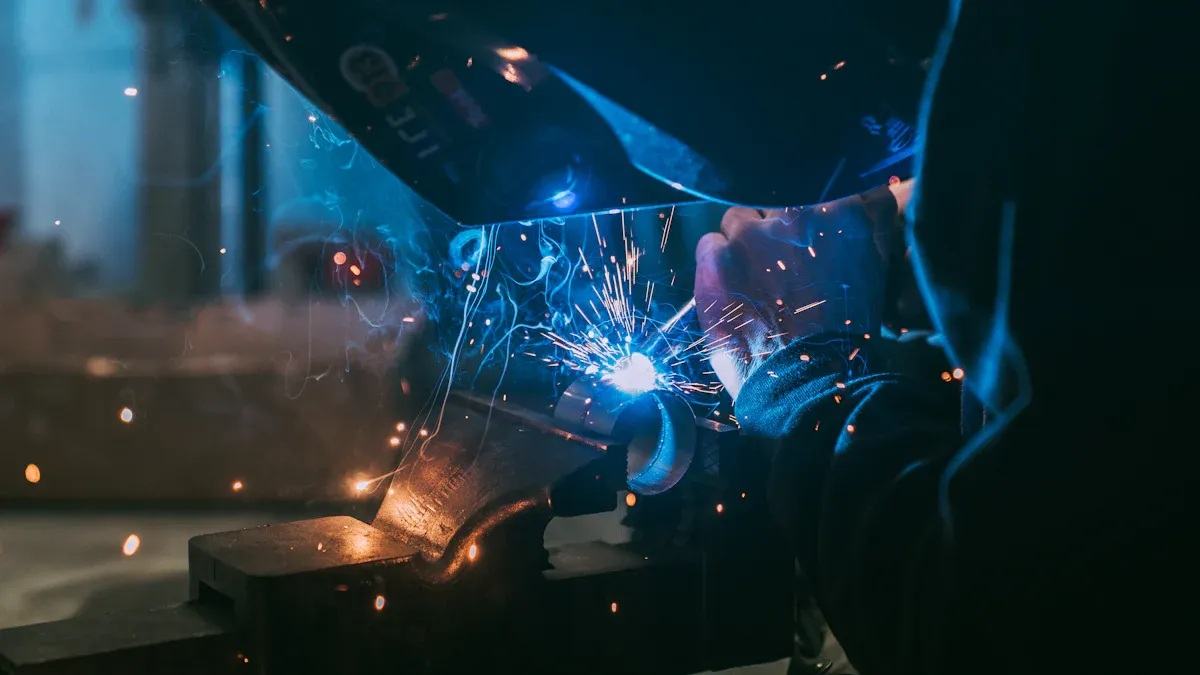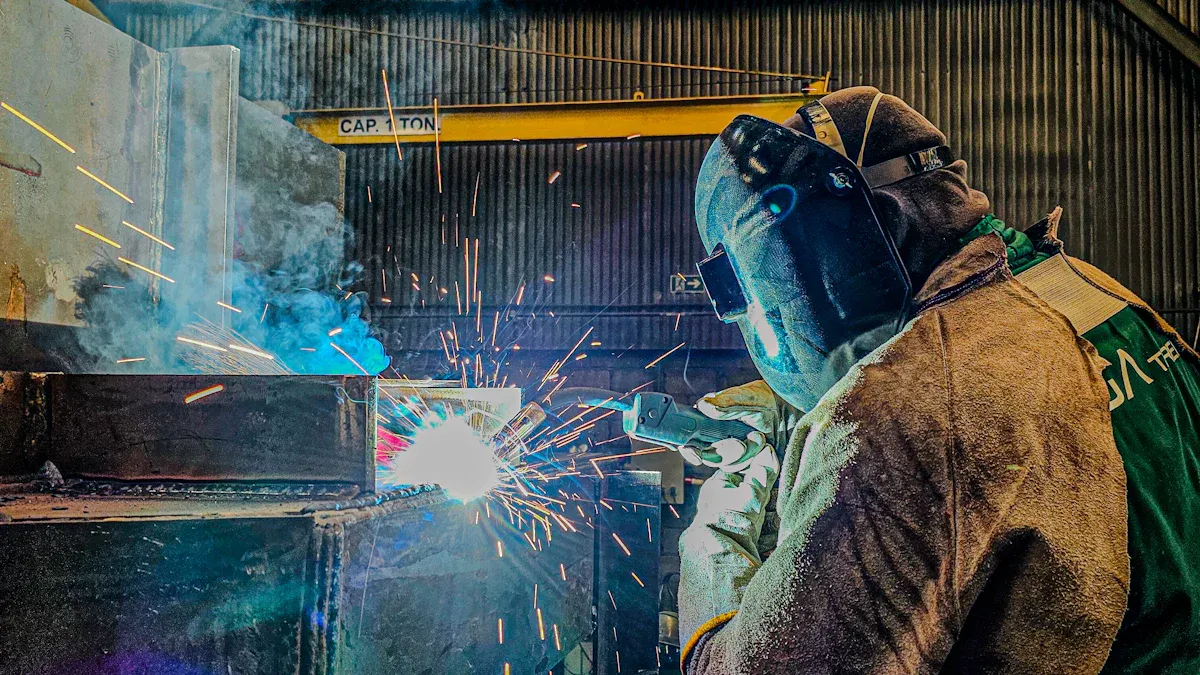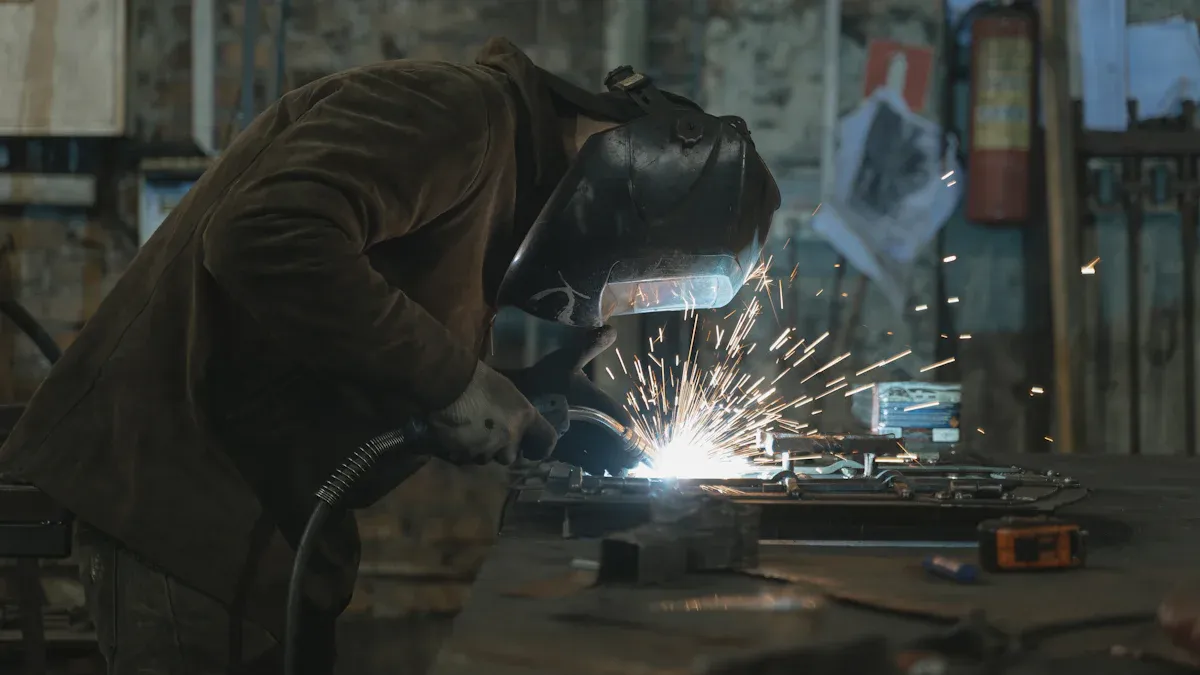The welded end structures of SMC and SMD

Welded end structures are important for SMC and SMD. They create a strong link between parts and PCBs. This link keeps the parts stable and secure. It also helps electricity flow without breaks, which is key for circuits to work well. These structures make devices more reliable and perform better. Their design affects how long and how well devices work. This makes them very important in making modern electronics.
Key Takeaways
Welded ends are important for attaching parts to PCBs. They keep parts stable and ensure electricity flows well.
SMCs are tiny parts good for basic circuits. SMDs are bigger and work better for harder jobs.
Good welded ends improve how devices work and last longer. Checking them often is very important.
Use SMCs for small designs. Pick SMDs for jobs needing strength and heat handling.
LTPCBA uses advanced soldering to make strong welded ends. This helps create reliable PCB assemblies.
Understanding SMC and SMD
What is SMC?
SMC means Surface-Mount Components. These are tiny parts that attach directly to a PCB. They are common in modern gadgets because they save space. SMCs also boost how well devices work. Examples include resistors, capacitors, and diodes. Each part has a job to keep devices running smoothly.
Tip: SMCs are great for small gadgets like phones and tablets. Their size and efficiency make them perfect.
What is SMD?
SMD stands for Surface-Mount Devices. These are full modules or parts using SMT to stick to PCBs. Unlike SMCs, SMDs combine many parts into one unit. You’ll find SMDs in LED lights, sensors, and circuits. They are faster to assemble and more reliable for electronics.
Key differences in their material composition and usage
Aspect | SMC | SMD |
|---|---|---|
Definition | Single electronic parts | Full electronic modules |
Size | Smaller and simpler | Bigger and more advanced |
Usage | Simple circuit tasks | Complex and multi-use tasks |
Material Composition | Made of metals, ceramics, or plastics | Mixes materials for many uses |
SMCs are best for simple circuits, while SMDs handle harder jobs. SMDs often combine several SMCs into one unit. This makes them more useful. Both are important for electronics, but their use depends on the device's needs.
Note: Knowing these differences helps you pick the right parts. This ensures your projects work well and efficiently.
Welded End Structures in SMC and SMD

Construction of welded end structures in SMC
In SMC, welded ends connect parts to the PCB. Solder paste is placed on PCB pads first. Then, the SMC is set on top of the paste. The assembly goes through reflow soldering. This process melts the solder paste, creating a strong bond. It keeps the part stable and lets electricity flow well.
Welded ends use metals like tin, lead, or silver. These metals are durable and conduct electricity well. Since SMCs are small, their welded ends must be perfect. Even tiny flaws can break the circuit. Strong welded ends help devices work better and last longer.
Construction of welded end structures in SMD
For SMD, welded ends are made differently. SMDs are bigger and more complex than SMCs. They often have many parts in one module. Their welded ends handle more stress and heat.
The process starts with solder paste, like in SMCs. But SMDs need extra steps, like automated checks for accuracy. Reflow soldering then bonds the SMD to the PCB. Advanced alloys are used for these welded ends. These alloys resist high heat and stress.
These welded ends are built to last. They keep the SMD firmly attached, even in tough conditions. This makes them great for industrial and high-performance uses.
Functional roles of welded end structures in electronic assemblies
Welded ends do important jobs in electronics. First, they keep parts stable on the PCB. This stops parts from moving or breaking under stress. This is crucial for devices that face impacts or vibrations.
Second, they ensure electricity flows without breaks. Good welded ends let circuits work properly.
To check welded ends, tests are done:
Impact Testing checks how much force the weld can take. It ensures the weld stays strong and flexible.
Destructive Weld Testing breaks the weld to test its strength. Tests like bending and pulling find weak spots.
These tests show why welded ends matter. They make devices strong and reliable. By ensuring stability and conductivity, they improve device performance and durability.
Comparing Welded End Structures of SMC and SMD
Structural differences between SMC and SMD welded ends
SMC and SMD welded ends are different in size and design. SMC welded ends are small and simple. They connect single parts like resistors or capacitors to the PCB. Their design must be precise because small mistakes can break circuits. Metals like tin or silver are used for strength and good electricity flow.
SMD welded ends are bigger and stronger. They hold entire modules with many parts. These ends handle more heat and stress than SMCs. Special heat-resistant metals are used to keep them stable. SMD welded ends are made for strength and work well in tough conditions.
Similarities in design and functionality
SMC and SMD welded ends also have things in common. Both use solder paste and reflow soldering to stick to the PCB. This keeps parts steady and working properly. The metals used in both are strong and conduct electricity well.
Both types help electricity move smoothly between parts and the PCB. They are built to handle vibrations and temperature changes. This makes devices more reliable and long-lasting.
Tip: Always check welded ends for quality. Good welded ends make devices work better and last longer.
Performance variations in different applications
How welded ends perform depends on where they are used. SMC welded ends are great for small devices like phones or tablets. Their tiny size fits well in tight spaces. But they don’t do well under heavy stress.
SMD welded ends are better for tough jobs. They are strong and handle more heat and pressure. You’ll see them in cars and other machines where durability is key.
Choose SMC welded ends for small, efficient designs. Pick SMD welded ends for projects needing strength and toughness.
Applications and Benefits of Welded End Structures

Industrial applications of SMC welded end structures
SMC welded ends are very useful in industries. They are light but strong for mechanical systems. For example, Marelli Ride Dynamics used SMC welded ends in suspension parts. This cut the weight of parts by 25%. They won the 2020 Enlighten Award for this design. Another project used digital twin tools to improve stiffness predictions. Errors dropped from over 25% to just 8%. Marelli also tested an omega-shaped beam with special software. This ensured it worked well in real conditions.
Company | Application | Outcome |
|---|---|---|
Marelli Ride Dynamics | Suspension parts | Reduced weight by 25% and won the 2020 Enlighten Award. |
Marelli Ride Dynamics | Digital twin tools | Lowered stiffness prediction errors from >25% to 8%. |
Marelli Ride Dynamics | Omega-shaped beam testing | Used Digimat software to confirm high accuracy. |
These examples show how SMC welded ends improve industrial systems' strength and efficiency.
Electronics applications of SMD welded end structures
SMD welded ends are key in electronics. They keep parts like LEDs and sensors securely connected. These ends handle heat and vibrations well. This makes them great for cars and airplanes. For example, in LED lights, SMD welded ends keep electricity flowing smoothly. This helps the lights last longer. In sensors, they provide stability for accurate data collection. Even in tough conditions, SMD welded ends ensure devices are durable and precise.
Advantages of welded end structures in PCB assembly by LTPCBA
LTPCBA makes top-quality welded ends for PCBs. These ends keep parts firmly attached to the PCB. LTPCBA uses advanced soldering methods for strong connections. This improves how devices work and last. They offer fast service, strict quality checks, and meet global standards. Whether you need prototypes or small production, LTPCBA delivers reliable assemblies.
Tip: Pick LTPCBA for your PCB needs. Their welded ends make devices stronger and better.
Welded end structures in SMC and SMD are very important. They create strong links, keep parts steady, and help electricity flow well. These features make devices work better and last longer. This is why they are crucial for both factories and everyday gadgets.
Note: Good welded ends make devices stronger and work longer.
For reliable PCB assemblies with great welded ends, check out LTPCBA. They use advanced tools and focus on quality. This makes them a trusted choice for electronics. Visit LTPCBA to learn more.
FAQ
What are welded end structures in SMC and SMD?
Welded ends join parts to PCBs. They keep parts steady and let electricity flow smoothly. These connections make devices work better and last longer by forming strong, dependable links.
Why are welded end structures important in electronics?
Welded ends hold parts firmly and keep electricity flowing. They stop parts from shifting or breaking under pressure. This helps devices stay efficient and durable, even in tough situations.
How do SMC and SMD welded ends differ?
SMC welded ends are tiny and simple, made for single parts like resistors. SMD welded ends are bigger and tougher, built for modules that handle more heat and stress. Each type fits different device needs.
What materials are used in welded end structures?
Common metals include tin, lead, and silver. These metals are strong and conduct electricity well. For SMDs, special alloys are used to handle higher heat and stress.
Why choose LTPCBA for PCB assembly?
LTPCBA makes strong welded ends using advanced soldering methods. Their assemblies meet global standards, ensuring great performance. With quick service and strict checks, LTPCBA is a reliable choice for PCB needs.
Tip: Check out LTPCBA to learn more about their PCB expertise.
See Also
A Comprehensive Overview of SMT and DIP Assembly Techniques
Evaluating Advantages and Disadvantages of SMD and Through-Hole Methods
Effective Strategies for Optimizing SMT Production Lines
Impact of Solder Paste Quality on SMT PCB Soldering
Importance of SPI Inspection Post-SMT Solder Paste Application in PCBA
